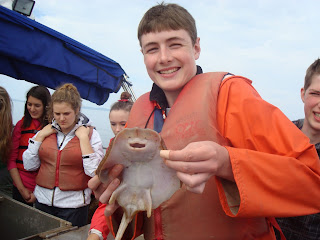Here Tracey shows the net that is used to collect plankton from the water.
The net is lowered over the boat and then dragged for a few minutes before it is brought back on board and the plankton is stored in jars.
Here the students study the differences between the phyto(plant)plankton and the zoo(animal)plankton.
Our catch from the scallop drag.
A large rock crab!
Everyone digs in to have a look at all the invertebrates!
After looking at a chart of the area, we used a salinometer to measure the salinity of the water and then a secchi disk to measure the size of the water column.
The crew fills this large tank with water to store the fish in while we are measuring them.
A number of lobster were caught in our net; they were all released back into the water.
This female lobster is carrying many eggs.
Everyone wanted a turn holding a lobster.
This was a particularly large lobster found.
Skates were also very popular.
This skate was cradled very gently before being placed back in the water.
Some students were not as keen as others to hold the skates.
The long-horn Sculpin are sometimes known as 'growlers' because of the noise they make when grinding the plates at the back of their throat together.
Another 'growler.'
The gulls were very excited to see the rest of the catch go overboard as they hoped to snag some before it made its way to the bottom.


















No comments:
Post a Comment